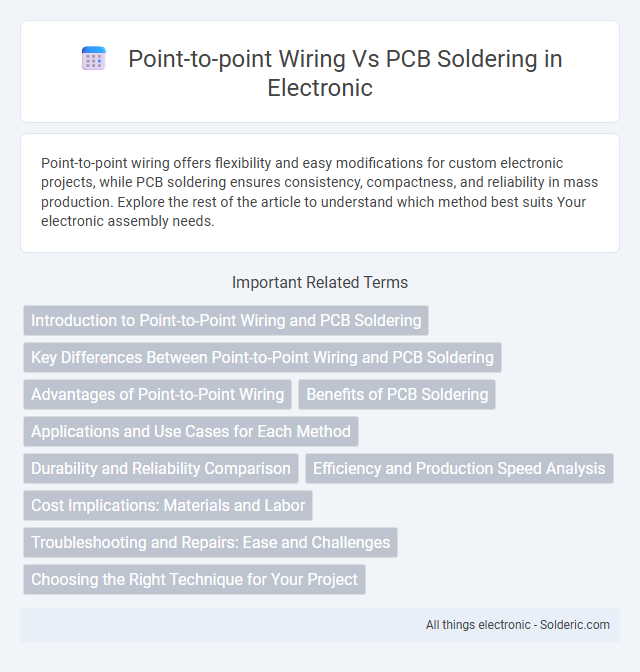Point-to-point wiring offers flexibility and easy modifications for custom electronic projects, while PCB soldering ensures consistency, compactness, and reliability in mass production. Explore the rest of the article to understand which method best suits Your electronic assembly needs.
Comparison Table
| Aspect | Point-to-Point Wiring | PCB Soldering |
|---|---|---|
| Definition | Direct wire connections between components | Components soldered onto a printed circuit board |
| Assembly Time | Longer, manual wiring required | Faster with automated soldering processes |
| Reliability | Prone to loose connections and wiring errors | High reliability with consistent solder joints |
| Flexibility | Highly flexible for prototyping and modifications | Less flexible, fixed layout after manufacturing |
| Complexity Handling | Challenging for complex circuits | Ideal for complex and high-density circuits |
| Cost | Low initial cost for small quantities | Cost-effective for mass production |
| Signal Integrity | Variable, depends on wiring quality | Better signal integrity due to optimized layout |
| Maintenance | Easier to repair and modify | Difficult to repair, requires desoldering |
Introduction to Point-to-Point Wiring and PCB Soldering
Point-to-point wiring involves directly connecting components with wires, offering flexibility for prototyping and repairs, commonly used in vintage electronics and custom circuits. PCB soldering attaches electronic components onto a printed circuit board, providing reliable connections, compact layouts, and suitability for mass production. Both methods impact circuit durability, assembly time, and signal integrity in electronic design.
Key Differences Between Point-to-Point Wiring and PCB Soldering
Point-to-point wiring involves manually connecting individual components with wires, offering flexibility for custom circuits but increasing assembly time and potential for errors. PCB soldering uses printed circuit boards with predefined copper traces, enabling compact, reliable, and repeatable connections ideal for mass production. You should choose point-to-point wiring for prototypes or low-volume projects and PCB soldering for scalable, consistent manufacturing.
Advantages of Point-to-Point Wiring
Point-to-point wiring offers superior flexibility and ease of modification, making it ideal for prototyping and custom low-volume electronics. This wiring method reduces parasitic capacitance and inductance, enhancing circuit performance in high-frequency applications. Your projects benefit from simplified troubleshooting and repairs thanks to the direct connection of components.
Benefits of PCB Soldering
PCB soldering offers enhanced reliability through consistent electrical connections and reduced risk of short circuits compared to point-to-point wiring. It enables precise component placement and efficient mass production, significantly improving manufacturing speed and quality control. The compact design of PCBs also optimizes space utilization and simplifies troubleshooting and maintenance processes.
Applications and Use Cases for Each Method
Point-to-point wiring is ideal for prototyping, custom electronics, and repair work where direct manual connections offer flexibility and quick modifications. PCB soldering excels in mass production, ensuring consistent performance and compact, reliable assemblies for consumer electronics and industrial devices. Your choice between these methods depends on project scale, complexity, and the need for durability or customization.
Durability and Reliability Comparison
Point-to-point wiring offers greater mechanical flexibility and ease of repair, but its exposed connections are more prone to oxidation, vibration damage, and inconsistent conductivity over time. PCB soldering provides superior durability with well-defined copper traces and controlled solder joints, enhancing long-term reliability in high-vibration and high-temperature environments. PCB assemblies minimize human error through automated processes, resulting in consistent electrical performance and reduced failure rates compared to hand-wired point-to-point constructions.
Efficiency and Production Speed Analysis
Point-to-point wiring requires meticulous manual connections, significantly reducing production speed compared to PCB soldering, which enables automated assembly and consistent quality. PCB soldering streamlines manufacturing processes, enhancing efficiency by minimizing errors and rework through precise component placement. Your choice impacts turnaround time and scalability, with PCB soldering favored in high-volume production environments for optimal efficiency.
Cost Implications: Materials and Labor
Point-to-point wiring typically incurs higher labor costs due to manual assembly and longer production times, despite using fewer materials. PCB soldering benefits from automated processes, reducing labor expenses and enabling precise, compact designs that minimize material waste. Overall, PCB soldering offers cost advantages for large-scale production, while point-to-point wiring may be more economical for small runs or prototypes.
Troubleshooting and Repairs: Ease and Challenges
Point-to-point wiring offers straightforward troubleshooting since individual connections are visible and accessible, making it easier to identify and repair faults without specialized tools. PCB soldering can complicate repairs due to densely packed components and multilayer traces, requiring advanced diagnostic equipment and skills to pinpoint issues. However, PCB repairs can be more precise and reliable once identified, especially with the use of rework stations and magnification tools.
Choosing the Right Technique for Your Project
Choosing between point-to-point wiring and PCB soldering depends on your project's complexity, durability requirements, and production scale. Point-to-point wiring offers flexibility and ease for prototypes or small runs, allowing quick modifications, while PCB soldering ensures precision, reliability, and consistency essential for mass production and compact designs. Assessing factors like electrical noise sensitivity, component density, and long-term maintenance will guide you to the optimal method for your application.
Point-to-point wiring vs PCB soldering Infographic

 solderic.com
solderic.com